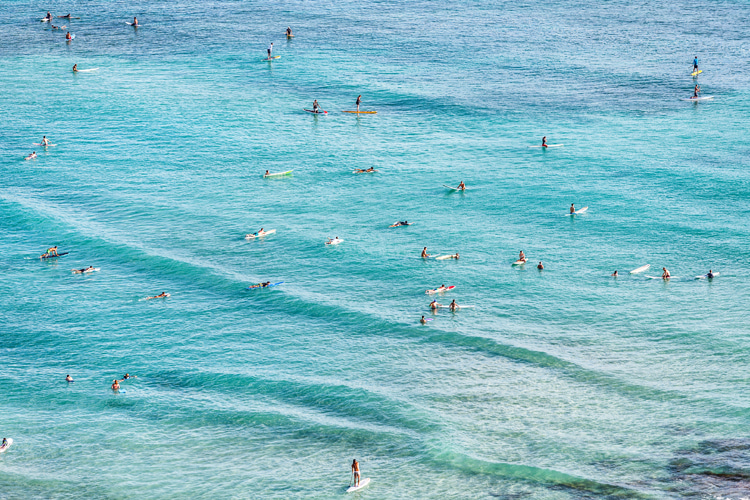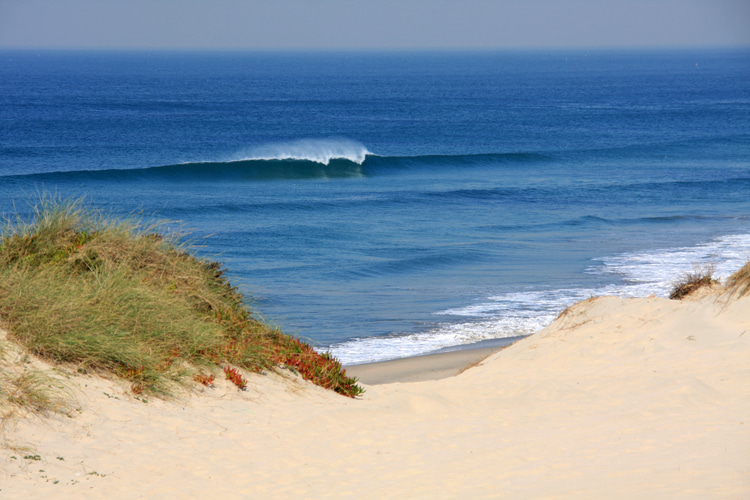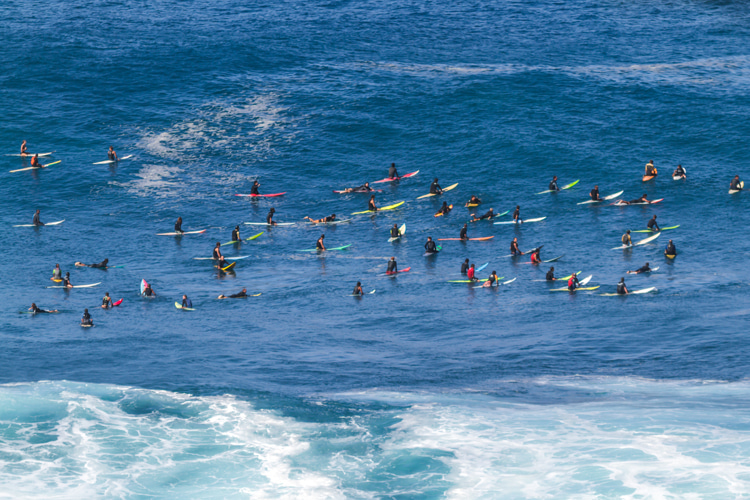Choosing the beach where we're heading for our next session is part of the surfing experience. However, in most cases, the decision involves a series of non-ocean-related variables.
If waves weren't scarce resources, our rational brain would lead us to the place where we could score the best waves, with distance to it being the only non-surf-related thing we would have to consider.
Sadly, we're not alone in the surfing world, and our greedy nature forces us to evaluate all possibilities to maximize fun.
Therefore, central to a surfer's quest is the eternal dilemma: should one opt for an uncrowded surf break with average waves, basking in solitude and consistency, or navigate the competitive tumult of crowded surf spots in pursuit of superior waves?
This dilemma reflects the diverse desires and philosophies surfers hold dear, and there is no definitive answer.
Each choice carries its own merits and drawbacks, and the decision ultimately depends on individual preferences and priorities.
Kelly Slater once said he'd rather surf in a spot with more average waves just for himself than be jockeying for position in a crowded lineup chasing epic sets.
But we've also seen him free surfing ultra-crowded point and reef breaks.
So, where do we draw the line? And do we always stick to the same decision-making formula?

Less is More: The Solitude of Uncrowded Breaks
Surfing in uncrowded surf breaks offers a serene and personal connection with Nature that many surfers cherish.
It might sound cheesy and kooky, but we've all been through it.
The solitude of an empty lineup provides an opportunity to escape from the hustle and bustle of daily life, offering a sense of peace and tranquility.
Surfers can commune with the ocean on their own terms, allowing for a deeper connection with the natural environment.
One of the most significant advantages of uncrowded surf breaks is the freedom to experiment and improve without the pressure of a crowded lineup.
Beginners can practice their skills with fewer distractions and anxiety, making it an ideal setting for skill development.
Advanced surfers, on the other hand, have the opportunity to test new maneuvers and push their limits without the fear of interfering with others.
Uncrowded surf spots also foster a sense of camaraderie among those who do venture to them.
Surfers bond over the shared experience of enjoying a hidden gem, and the absence of competition for waves can lead to more relaxed, friendly atmospheres.
In summary, it often translates into a more relaxed, meditative experience, suitable for surfers who find bliss in seclusion and the simple act of riding a wave, irrespective of its grandeur.
However, the glamour of uncrowded breaks comes with its own challenges.
These spots are often more remote, requiring longer journeys and sometimes even more treacherous access.
Additionally, finding uncrowded breaks can be daunting, as many are closely guarded secrets among local surfers.
The unpredictability of wave quality at such spots can also be a drawback, as one may encounter average or subpar waves more frequently.
There should be a reason these breaks are uncrowded, and in most cases, it's because waves aren't that good.
Nevertheless, if you're willing to sacrifice quality and size for an exclusive session where you can pick all the waves you want, then this is the way to go.

Epic Is Memorable: The Appeal of Crowded Surf Spots
In contrast, crowded surf spots are renowned for delivering consistent and high-quality waves. Think about Kirra, Lower Trestles, or even Pipeline.
The fact that these spots attract many surfers is a testament to their wave-riding potential.
The allure of catching the perfect wave amidst a throng of fellow surfers can be intoxicating. Or not at all.
Nevertheless, surfing at crowded spots offers the opportunity to connect with a vibrant and diverse surfing community.
It sounds impossible, but sometimes the stars and planets align, and you can actually feel unexpected good vibes in a packed lineup.
Surfers from all walks of life converge at these popular locations, creating a lively atmosphere filled with shared excitement and enthusiasm.
The camaraderie among surfers is palpable, and the sense of belonging to a larger tribe is a powerful draw.
Rare but possible.
Another advantage of crowded surf spots is the predictability of wave quality.
These locations are renowned for delivering epic rides, ensuring that surfers can maximize their time in the water by catching excellent waves more frequently.
However, crowded surf spots come with their own set of challenges.
Competition for waves can be fierce, leading to tension, frustration, and occasional conflicts among surfers.
Episodes of localism and territorialism are often more frequent than moments of sharing and chatting.
The crowded lineups can also be intimidating for beginners and may hinder skill development due to the pressure to perform.
But every day is a new day.
Sometimes, it's inevitable to follow the flock, test your luck and confidence, and see if you can get one wave that makes it worth playing the game.
The Decision: Small and Secluded vs. Unforgettable and Packed
Ultimately, the decision to surf in an uncrowded break with average waves or a crowded spot with the potential for epic rides is a deeply personal one.
It depends on individual preferences, skill level, and what one seeks to gain from the surfing experience.
Some surfers prioritize loneliness or isolation and the deep connection with Nature that uncrowded breaks provide.
They relish the freedom to experiment, develop their skills, and escape from the chaos of the crowded world.
Others crave the energy and camaraderie of crowded peaks, valuing the opportunity to be part of a community and the chance to ride outstanding waves here and there.
There are no right or wrong choices - just preferences (that can shift weekly).
